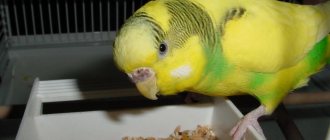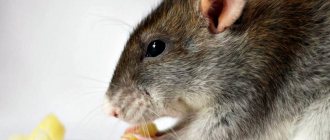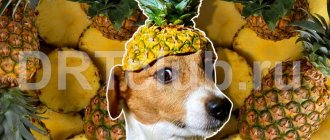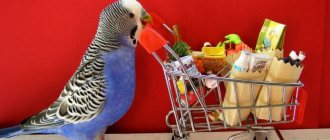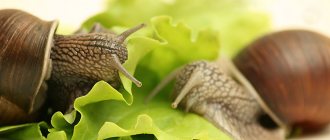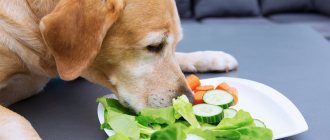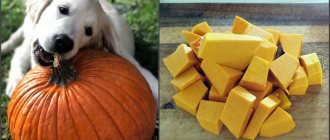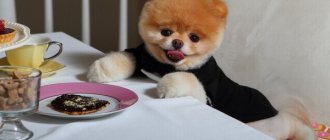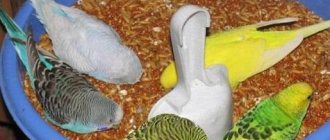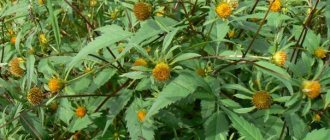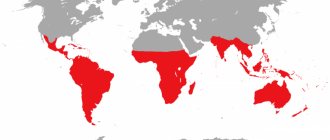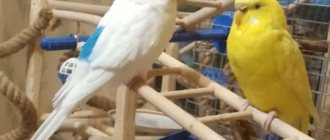The food preferences of birds depend on the species and size. Large specimens, which spend incomparably more energy on maintaining vital energy in the body, prefer fruits and vegetables, flowers, nuts and berries; small budgies and lovebirds consume grain, various mixtures when it comes to keeping them at home, as well as porridge.
Before buying a feathered friend, you should make sure in advance that the new owner is able to satisfy all his needs, find out which food is best, whether it is always worth buying food, and perhaps actually prepare it yourself.
Fruits
A budgie or lovebird that has just found a new home should be offered to try the pulp instead of balanced dry food or together with it:
- oranges;
- tangerines;
- grapefruit;
- lime
Poultry will not refuse banana and pineapple, watermelon puree and melon. You don’t have to remove the peel from the fruit, but before filling the feeder with fruit, you will have to wash it with warm water and soda. Many budgies eat all the berries that are offered to them.
But, for example, viburnum is prohibited as the main food for lovebirds with kidney disease, but healthy birds love it (it should be given in small portions, freed from seeds).
Fruits and berries are given fresh or defrosted. There are few contraindications, the only thing, for example, is that the aratingas do not like mangoes. Moreover, this fruit is contraindicated for them, so before purchasing anything exotic for your pet, you should make sure that a particular fruit or berry is safe for its body. If you cannot find out on your own about the safety of a particular fruit or vegetable or food, you need to contact a veterinary clinic.
Kalina.
Mango.
Dried fruits purchased in the store, before distributing to feeders, are soaked and washed in warm water, using a toothbrush, and any dust or debris that may stick to their surface is cleaned out. Both dried fruits and fresh berries are pitted. Pears, apples, apricots, peaches, plums, quinces and grapes are divided into several parts and completely cleared of stems and peels. Accordingly, there should be no seeds in them.
Some lovebirds love pomegranates. But since they themselves consist of seeds, before transferring the fruit to the bird, the skin is removed from it. When feeding fruits and berries, you should never overdo it; for example, grapes can be fed daily, but not allowing the bird to eat more than 3-4 berries at a time. Otherwise, the same lovebird may develop food poisoning or indigestion.
Pomegranate.
Grape
Water for parrots
By studying the materials published on our website, you may have already learned about what a drinker is, what it is needed for and how to choose it correctly. Water is essential for parrots, as for all other living creatures on our planet.
You can install a saucer of water in a parrot's cage, but this option is considered far from the most convenient, since the parrot can easily turn it over and water will splash throughout the cage.
If you are not at home at this time, then the parrot will have to sit without water all day, and, as you understand, there is little benefit in this. It is much better to install a comfortable drinking bowl, which is recommended to be filled with filtered water.
Boiled water can be used, but is not recommended, since it contains very little oxygen and other useful elements. By the way, feeding a parrot with raw tap water is strictly prohibited!
You can buy water for your parrot in the store, but it will be much more profitable to simply install a water filter - this is not only more profitable from a financial point of view, but will also be useful for you, since clean water is useful not only for parrots, but also for people.
Vegetables
Vegetables are no less useful. The daily menu of an adult lovebird should contain no less vegetables than fruits. Many birds simply love:
Fresh carrots (the tops don’t need to be torn off, the birds eat them too, not disdaining even slightly dried greens.
Sweet and even hot peppers are eaten together with the seeds, the main thing is to make sure that the vegetable is well washed and does not contain signs of disease (mold, black spots, rot).
Tomatoes and cucumbers.
Rutabagas, turnips and turnips are pre-blanched.
Squash, pumpkin, squash and zucchini can be given directly with the seeds.
Beetroot and beet tops.
Brussels sprouts and kohlrabi, scalded with hot water.
Celery, green peas and beans in pods (need to be blanched).
Broccoli and cauliflower (vegetables are kept in boiling water for 3-5 minutes).
The lovebird parrot will not refuse a fresh ear of corn, especially sweet sugar varieties. Half the average size of an ear of cob per day is enough to satiate. At the same time, corn can be used not only for satiation, but also for games, entertainment is guaranteed for both it and the owner.
In the summer, the parrot is fed leaves of young nettles, spinach, lettuce, honey and plantain. Greens contain all the vitamins a bird needs; the main thing is to collect it correctly. It is advisable to do this away from roads and any sources of dust pollution. Before distribution, the leaves are treated in hot water and crushed. You can add greens to porridge or grain mixture.
Mineral components and vitamins
Eggshells contain calcium.
Mineral supplements are needed to provide the body with microelements that are necessary for the formation of skeletal bones.
The cage must contain sepia (part of the cuttlefish skeleton), which is an excellent source of calcium. Bird chalk or pre-boiled and dried eggshells also work well. For those who are just finding out what else a parrot eats at home, you should know about some more mineral supplements:
1. Bone meal. Together with egg shells, it is a source of phosphorus and calcium, which strengthens bones and feathers. Such additives are added to poultry sand or wet feed mixtures.
Flour is especially important during seasonal molting, because it nourishes the body of the wavy with salts, which are important in the formation of feathers. This simple and inexpensive feeding is sold in ordinary pet stores.
2. Small pebbles with sand. Under natural conditions, wild parrots eat such components along with other food. In the bird's stomach, they mechanically grind food and aid in digestion and enzymatic breakdown.
Sand for birds is sold everywhere in sealed packs. It is prohibited to use plain sand from beaches or construction sites, as there is a risk of parasite infection.
3. Charcoal. In nature, budgies get it from the bark of trees. It contains important microelements.
It is ground and sprinkled onto the birds along with egg shells and sand. It removes heavy compounds, poisons and gases from the organs of a feathered friend.
Cereals
Budgerigars and lovebirds are often fed:
Wheat.
Prosom.
Oats.
Rice.
barley (the main thing is to ensure that all sharp spikelets are removed).
You can give buckwheat and corn. But they do this carefully; corn, for example, can cause obesity, and not all birds like buckwheat. Wood shavings, pine cones, and unpainted cardboard are added to the bowl with grain.
During the mating period, budgies and lovebirds are fed sprouted grain. Sprouted grains help activate the sexual instinct. They contain more nutrients and vitamins than regular ones.
Porridge
Porridges for budgies and lovebirds are prepared from the same ground grains, for example, millet or corn flour; oatmeal and rice flakes are also consumed with great enthusiasm.
Porridges are cooked in water; milk and any dairy products, with the exception of cottage cheese, kefir, yogurt and fermented baked milk, should be excluded from the bird’s diet. Also, the porridge is not salted or sugar or any other ingredients besides water and flour are added to it, therefore the product that is prepared by a person for his own consumption is not suitable.
Proper diet for a parrot
If you are the proud owner of a parrot, then you need to take into account that the daily food intake should be approximately 20 grams of food.
By the way, a similar amount of food is recommended for small parrots, for example, budgies and lovebirds. If you have a larger parrot, then it needs about 40-50 grams of food.
In general, one should not assume that this volume is optimal for all parrots, since each case is unique and requires an individual approach, therefore, you can create the correct diet for a parrot only experimentally, that is, by checking how much food it needs and what kind of food it needs. it is the products he prefers.
The amount of food directly depends on a large number of factors, for example, on the air temperature in the room in which the parrot lives.
Of course, if it’s cold in your apartment or house, then the parrot will need much more energy to warm up, and accordingly, it will need more food.
There are quite a lot of such factors, so we advise you to try different variations of products and their volume.
Minerals
Artificial vitamins and minerals are fed approximately once a quarter. The course of treatment is 2 weeks. The ideal mineral supplement of natural origin is considered to be sepia or cuttlefish shell, which is left in the cage until it is completely crushed by the bird. If a budgerigar consumes sepia, then it does not need additional supplements containing calcium, but it is impossible to completely abandon vitamins. For example, for better absorption of the substances contained in the shell, vitamin D is needed, as well as an amino acid. Amino acids are found in cereals. Most of them are found in buckwheat, wheat, wild rice and oats, and legumes. Calcium is found in spinach and beet tops.
Some owners, in their desire to maintain the health of lovebirds at the proper level, oversaturate the bird’s body with fish oil containing vitamins A, D, E. But a large amount of seemingly necessary substances can be harmful.
There are many advantages
Expiration date
The proposed mixture-based diet has many advantages over others. This is what you can, and what I recommend, feed parrots in addition to (or better yet, instead of) food. The mixture can be left in the feeder for a long time. Since most of the ingredients in the mixture are given raw, and the mixture itself is relatively dry, it does not create conditions for rapid growth of bacteria. As is often the case with other legume-based or chopped vegetable and fruit mixtures, due to their excessive moisture.
Possibility to choose
The mixture also leaves the parrot with a choice: he eats in proportion to his appetite and the nutritional needs of his body. We must do everything possible to provide freedom of choice and freedom of movement for our birds. That is, give them those two things that they first of all lose when they fall into captivity. We must do everything possible to somehow make up for their lost freedoms.
Diversity
And one more advantage: preparing the mixture is a creative process. There is no end to the variations of this mixture. Once a week I change the composition of one of the layers. I choose other types of greens and other vegetables to cut. I can use lemon and kumquat instead of orange in the citrus layer. I can replace the grapes with blueberries and/or cherries (pitted). Use red bell peppers instead of green bell peppers. Vary the shape of the pasta you use: one week I give you tiny letters or stars, another week I give you wheels.
Each morning I stir the mixture and add other foods to provide even more variety to my diet. This could be canned peas (chickpeas), sesame seed sprouts or other seeds, lightly boiled grains of cereals or other plants (brown rice, millet, amaranth, quinoa), carambola, lightly chopped nuts (Brazil, almonds, walnuts, etc.). d) or pieces of toast with a thin layer of peanut butter. I may use small canary seed instead of a seed mixture for larger parrots. I can choose another granulated food for feeding parrots. In general, there is no end to the variety. My birds never know what awaits them at the feeders and rush to them with all their might to find out.
Way to switch
One more thing: this mixture is the fastest way I know of switching birds that are used to eating exclusively seeds to fresh food and pelleted food. I give this mixture to a wide variety of birds, both wild-caught and hand-fed. And even to abandoned birds who are accustomed to living exclusively on seeds.
There is not a single bird that is not quickly tempted to try the mixture. Because Ultimately, the mixture contains 10% seeds, very little effort is required to persuade even the most inveterate stubborn person to accept it. While choosing seeds from the feeder, the parrot also tastes and eats pieces of fresh food. The parrot does not suffer from hunger, because... eats seeds. And soon he gets used to fresh food. For particularly stubborn birds, I add an extra tablespoon of seeds to each feeder until they get used to the mixture. It is also important that since the mixture consists of 10% granulated food, those birds that have not previously eaten dry granulated food at all begin to eat it as part of the mixture.
Health
This mixture allows parrots to be beautiful and healthy birds. Once, after molting, I saved the feathers of rejected birds, and then compared them with the feathers of the same birds a year later this week. The difference was obvious and impressive.
Discontent
Only once did I hear a dissatisfied response regarding this method of feeding. The owner was unhappy that too many fruits and vegetables from the mixture ended up at the bottom of the cage. However, it is necessary to understand that parrots are designed this way. This is their usual way of eating - take a piece of food, bite off a little of it and throw away the rest.
I have been puzzled several times by clients who say, “my chick won’t eat anything.” My bewilderment was caused by the fact that the chicks ate with appetite at my house and were on a similar diet at theirs. But upon further questioning, it turned out that the chicks fed in their usual manner, described above. And due to the fact that a lot of food ended up at the bottom of the cage, the new owners worriedly thought that the chicks were not eating anything at all. All parrots behave this way in nature. Thanks to them, fallen food acts as a nutritious mulch for plant seeds and helps ensure their germination. And ultimately promotes the flourishing of lush vegetation in the parrots' habitat. Those who can't stand losing parrot food can use it for chickens or to form compost.
Branches
The gastronomic preferences of budgies and aratingas depend on the season; in the summer they love fruits and berries, and in the spring they need branches of fruit trees. In spring, it is important to fill the bird’s cage with birch and other deciduous branches.
The branches of elm and hawthorn, covered with delicate, young bark, will also not leave any budgie or aratinga indifferent. The branches are washed in warm water, and sometimes in boiling water.
In the cold season, you can keep the twig in water for some period until buds appear on it.
Ready mixes
Budgerigars love ready-made nut and grain mixtures. Everything is clear with grain, the mixture can consist of corn, oats and wheat, rice mixed with millet. It is more difficult to make a nut mixture yourself, primarily because some types of nuts are contraindicated for budgies and any other representatives of the species.
Mixtures containing pistachios, pecans, sweet almonds and madacamia, and peanuts (need to be peeled) are considered ideal in composition and taste.
What to feed the chicks
Babies that have recently hatched from eggs are completely helpless. They need parental care. The female feeds the newborns with crop milk, which consists of partially digested grain. If the female abandons her children or dies, the breeder has to take on the role of mother and decide what to feed the chicks.
The most convenient option is to buy ready-made food for small parrots, for example, NutriBird A19 mixture. The powder should be diluted to a thickness that suits the chick. Babies should be fed every two hours, gradually increasing the time between feedings to four hours. Hungry chicks themselves will demand food, calling invitingly at the sight of the owner.
What else can you give?
Animal food is also useful for lovebirds, other birds kept at home, for example, birds are occasionally fed:
- kefir;
- fermented baked milk;
- curdled milk;
- yoghurts;
- children's fruit curds;
- cottage cheese.
You can add 1 drop of honey to the cottage cheese. Boiled chicken and quail eggs are also useful. Birds will not ignore grasshoppers and other living creatures, but it is better to purchase live food in specialized stores to avoid infecting birds with parasites.
